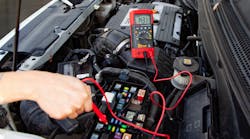- When looking at a wiring diagram, don’t try to focus on the whole page all at once. It’s overwhelming. Put a blank sheet of paper next to the wiring diagram and just draw the simple circuit. Focus on the simple part and follow the current flow from power to ground or from ground to power. All complex wiring diagrams are just a series of simple diagrams, and it makes it hard to look at if you don’t narrow down to the circuit that you’re doing. –John Renno, Manager, Center of Excellence, Isuzu Commercial Trucks
- Print the wiring diagram off and use highlighters to trace the circuit. When you use your finger or follow the circuit with your eyes, it’s easy to mistrace the circuit. One trick that I use is to print the same wiring diagram off twice. On one, I’ll trace the current flow, how it operates, and that shows me what parts of the circuit I need to check. Then on the other one, I’ll start coloring the things that tested okay. When I get done, anything that’s not highlighted are suspect circuits that I need to identify. –Keith Littleton, Trainer and Owner, K&D Technical Innovations
- To properly read a wiring diagram, one has to know how the components in the system operate. For example, if a module is powered up and it sends out a signal of half the voltage and the technician does not know this, he would think he has a problem, as he would expect a 12V signal. Following diagrams is fairly simple, but using it within the scope of how the system operates is a different matter. My best advice is not only look at the diagram, but understand how the components operate when in use. –Bruce Purkey, Founder of Purkeys and consultant for Auto Meter Products
- Read wiring diagrams from negative to positive and redraw the circuit as a straight line. All circuits are the same – voltage, ground, single component, and switches. –Steve White, President, Electronic Specialties
- Before reading a schematic, get familiar and understand all the symbols. Read the schematic like a roadmap. I print the schematic and highlight the circuit I’m diagnosing to make sure I’m staying on the right path. –Gerald Tabas, ASE Master Technician, Power Probe Tek
Sponsored Content
Whitepapers
Trailer Inspection Form
Nov. 10, 2023





